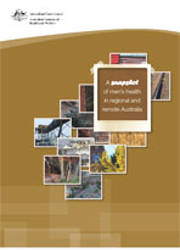Summary
In late 2008, the Australian Government announced its intention to develop Australia’s first National Men’s Health Policy, which will have a focus on a number of groups including men in rural areas. Drawing on several data sources, this report provides a snapshot of the health of men in rural Australia compared with urban areas.
Why rural men?
There is a strong relationship between poor health and social and economic disadvantage. Compared with urban areas, rural regions of Australia contain a larger proportion of people living in areas of socioeconomic disadvantage. This fact, combined with the generally poorer health status of men compared with women, justifies the specific consideration of rural men in this report.
Room for improvement in the health of rural men
This report confirms previous findings that rural men are more likely than their urban counterparts to experience chronic conditions and health risk factors.
In 2004–06, male death rates increased with remoteness. Compared with Major cities, death rates ranged from 8% higher in Inner regional areas to up to 80% higher in Very remote areas.
Several areas of health continue to be of particular concern for rural men. Four of these are highlighted below.
Cardiovascular disease and diabetes
Death rates from these diseases increased with remoteness. Cardiovascular diseases were responsible for nearly a third of the elevated male death rates outside Major cities.
Male death rates from diabetes were 1.3 times as high in Inner regional areas and 3.7 times as high in Very remote areas as compared with Major cities.
Alcohol and other drugs
Men living outside Major cities were more likely to report daily smoking and risky or high-risk alcohol use than their counterparts in Major cities. They were also more likely to have experienced a substance use mental disorder throughout their lifetime. The incidence of head and neck cancers and lip cancers, two groups of cancers associated with increased smoking and alcohol consumption, was also higher outside Major cities.
Injury
Male death rates due to injury and poisoning increased with remoteness; rates in Very remote areas were 3.1 times as high as Major cities. Similarly, men living outside Major cities were 18% more likely to report a recent injury.
Health literacy
In 2006, men living in Inner regional and Outer regional/Remote areas were 22% less likely than men in Major cities to possess an adequate level of health literacy.
Preliminary material: Acknowledgments; Abbreviations
1. Introduction
- Background
- Why men?
- Why men in rural areas?
- Purpose and structure of this report
2. Analysis methods
- Classifying remoteness
- Adjusting for different age profiles
3. Men in rural Australia
- Characteristics and demographics
- Socioeconomic status and the rural–urban health gap
4. The health of men in rural Australia
- Health determinants
- Self-assessed health status
- Health conditions
- Cancer
- Mental disorders
- Changes in health status over time
5. Men in the general practice setting
- General practice data
- Why do men visit a GP?
- What health problems do GPs manage for men?
- How are health problems managed?
6. Mortality
- What are rural men dying from?
- How much higher are rural death rates?
- How has rural mortality changed over time?
- What health problems contribute to higher rural death rates?
- Life expectancy
- Marriage and mortality
- Mortality across states/territories
Appendixes:
Appendix A: Data sources and methods
Appendix B: Detailed tables
End matter: References; List of tables; List of figures



